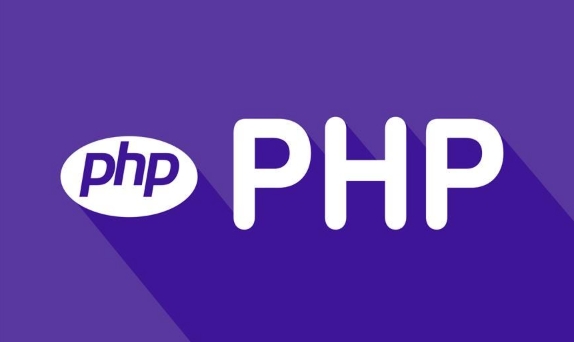PHP 8.1 introduces a new feature - a level-one callable syntax, allowing developers to refer to functions or methods as closures more concisely. 1. Through the fn() syntax or... operator, developers can directly convert existing functions or methods into real Closure objects without manually encapsulating or using Closure::fromCallable(); 2. This feature is suitable for advanced function scenarios such as array_map, policy mode, etc. that require callbacks to be passed; 3. Notes include: slight performance overhead, no automatic inheritance of parent variable scope, and only support PHP 8.1 and above. This feature improves the readability and maintenance of the code.

In PHP 8.1, a first-class callable syntax is a new feature that allows developers to reference functions or methods as closings without having to manually wrap them in a closure or use Closure::fromCallable() . This makes it easier and cleaner to pass functions around as values.

How First-Class Callable Syntax Works
Prior to PHP 8.1, if you wanted to pass a function as a callback, you had to either define it inline or use an array syntax like [SomeClass::class, 'someMethod'] , which wasn't actually a closure until invoked. Now, with the fn() syntax, you can directly convert any callable into a closure instance:

$callable = fn($x) => $x * 2;
This creates a closure from an anonymous function immediately. But more importantly for first-class calls, you can now reference existing functions and methods using this same syntax in a slightly different way.
Cleaner Way to Reference Existing Functions
One of the most useful aspects of this feature is referencing existing named functions or object methods without needing to write extra code.

For example:
function greet($name) {
echo "Hello, $name";
}
$greetFunction = greet(...); // This creates a closure from the greet function
$greetFunction('John'); // Outputs: Hello, John Here, greet(...) is shortand syntax that tells PHP to take the greet function and turn it into a proper closure. This works with static methods, instance methods, and even namespaced functions.
Some key points about this syntax:
- It's concise and avoids boilerplate.
- The resulting value is a true
Closureobject. - You can pass these closings around just like any other variable.
Use Cases and Practical Benefits
This feature becomes especially handy when working with higher-order functions — functions that accept other functions as arguments or return them.
Common scenarios include:
- Passing callsbacks to array functions like
array_map,array_filter, etc. - Implementing strategies or command patterns where behavior needs to be swapped dynamically.
- Creating decorator-like wrappers around functions or methods.
Let's say you're mapping over an array:
$numbers = [1, 2, 3]; $squared = array_map(fn($n) => $n ** 2, $numbers);
Or if you have a predefined function:
function formatName($name) {
return ucfirst(strtolower($name));
}
$names = ['ALICE', 'BOB'];
$formattedNames = array_map(formatName(...), $names); Now $formattedNames will contain ['Alice', 'Bob'] .
Before PHP 8.1, you would have needed to pass 'formatName' as a string or use Closure::fromCallable() , both of which were less expressive or more verbose.
Things to Watch Out For
While this feature simplifies many patterns, there are a few caveats to keep in mind:
- Performance considerations : There might be a tiny overhead compared to direct inline closings, but it's negligible for most applications.
- Variable scope : Unlike traditional anonymous functions, first-class callable syntax doesn't import variables from the parent scope automatically. If you need access to external variables, you'll still need to use the full
fn($x) => ...form. - Backward compatibility : Since this is only available in PHP 8.1 , make sure your project supports that version before adopting it widely.
So while it looks simple on the surface, the first-class callable syntax brings real improvements to how readable and maintainable PHP code can be.
Basically that's it.
The above is the detailed content of What is a first-class callable syntax in PHP 8.1?. For more information, please follow other related articles on the PHP Chinese website!

Hot AI Tools

Undress AI Tool
Undress images for free

Undresser.AI Undress
AI-powered app for creating realistic nude photos

AI Clothes Remover
Online AI tool for removing clothes from photos.

Clothoff.io
AI clothes remover

Video Face Swap
Swap faces in any video effortlessly with our completely free AI face swap tool!

Hot Article

Hot Tools

Notepad++7.3.1
Easy-to-use and free code editor

SublimeText3 Chinese version
Chinese version, very easy to use

Zend Studio 13.0.1
Powerful PHP integrated development environment

Dreamweaver CS6
Visual web development tools

SublimeText3 Mac version
God-level code editing software (SublimeText3)
 PHP Variable Scope Explained
Jul 17, 2025 am 04:16 AM
PHP Variable Scope Explained
Jul 17, 2025 am 04:16 AM
Common problems and solutions for PHP variable scope include: 1. The global variable cannot be accessed within the function, and it needs to be passed in using the global keyword or parameter; 2. The static variable is declared with static, and it is only initialized once and the value is maintained between multiple calls; 3. Hyperglobal variables such as $_GET and $_POST can be used directly in any scope, but you need to pay attention to safe filtering; 4. Anonymous functions need to introduce parent scope variables through the use keyword, and when modifying external variables, you need to pass a reference. Mastering these rules can help avoid errors and improve code stability.
 How to handle File Uploads securely in PHP?
Jul 08, 2025 am 02:37 AM
How to handle File Uploads securely in PHP?
Jul 08, 2025 am 02:37 AM
To safely handle PHP file uploads, you need to verify the source and type, control the file name and path, set server restrictions, and process media files twice. 1. Verify the upload source to prevent CSRF through token and detect the real MIME type through finfo_file using whitelist control; 2. Rename the file to a random string and determine the extension to store it in a non-Web directory according to the detection type; 3. PHP configuration limits the upload size and temporary directory Nginx/Apache prohibits access to the upload directory; 4. The GD library resaves the pictures to clear potential malicious data.
 Commenting Out Code in PHP
Jul 18, 2025 am 04:57 AM
Commenting Out Code in PHP
Jul 18, 2025 am 04:57 AM
There are three common methods for PHP comment code: 1. Use // or # to block one line of code, and it is recommended to use //; 2. Use /.../ to wrap code blocks with multiple lines, which cannot be nested but can be crossed; 3. Combination skills comments such as using /if(){}/ to control logic blocks, or to improve efficiency with editor shortcut keys, you should pay attention to closing symbols and avoid nesting when using them.
 How Do Generators Work in PHP?
Jul 11, 2025 am 03:12 AM
How Do Generators Work in PHP?
Jul 11, 2025 am 03:12 AM
AgeneratorinPHPisamemory-efficientwaytoiterateoverlargedatasetsbyyieldingvaluesoneatatimeinsteadofreturningthemallatonce.1.Generatorsusetheyieldkeywordtoproducevaluesondemand,reducingmemoryusage.2.Theyareusefulforhandlingbigloops,readinglargefiles,or
 Tips for Writing PHP Comments
Jul 18, 2025 am 04:51 AM
Tips for Writing PHP Comments
Jul 18, 2025 am 04:51 AM
The key to writing PHP comments is to clarify the purpose and specifications. Comments should explain "why" rather than "what was done", avoiding redundancy or too simplicity. 1. Use a unified format, such as docblock (/*/) for class and method descriptions to improve readability and tool compatibility; 2. Emphasize the reasons behind the logic, such as why JS jumps need to be output manually; 3. Add an overview description before complex code, describe the process in steps, and help understand the overall idea; 4. Use TODO and FIXME rationally to mark to-do items and problems to facilitate subsequent tracking and collaboration. Good annotations can reduce communication costs and improve code maintenance efficiency.
 How to access a character in a string by index in PHP
Jul 12, 2025 am 03:15 AM
How to access a character in a string by index in PHP
Jul 12, 2025 am 03:15 AM
In PHP, you can use square brackets or curly braces to obtain string specific index characters, but square brackets are recommended; the index starts from 0, and the access outside the range returns a null value and cannot be assigned a value; mb_substr is required to handle multi-byte characters. For example: $str="hello";echo$str[0]; output h; and Chinese characters such as mb_substr($str,1,1) need to obtain the correct result; in actual applications, the length of the string should be checked before looping, dynamic strings need to be verified for validity, and multilingual projects recommend using multi-byte security functions uniformly.
 Quick PHP Installation Tutorial
Jul 18, 2025 am 04:52 AM
Quick PHP Installation Tutorial
Jul 18, 2025 am 04:52 AM
ToinstallPHPquickly,useXAMPPonWindowsorHomebrewonmacOS.1.OnWindows,downloadandinstallXAMPP,selectcomponents,startApache,andplacefilesinhtdocs.2.Alternatively,manuallyinstallPHPfromphp.netandsetupaserverlikeApache.3.OnmacOS,installHomebrew,thenrun'bre
 Learning PHP: A Beginner's Guide
Jul 18, 2025 am 04:54 AM
Learning PHP: A Beginner's Guide
Jul 18, 2025 am 04:54 AM
TolearnPHPeffectively,startbysettingupalocalserverenvironmentusingtoolslikeXAMPPandacodeeditorlikeVSCode.1)InstallXAMPPforApache,MySQL,andPHP.2)Useacodeeditorforsyntaxsupport.3)TestyoursetupwithasimplePHPfile.Next,learnPHPbasicsincludingvariables,ech






